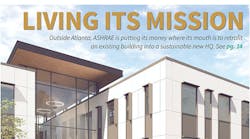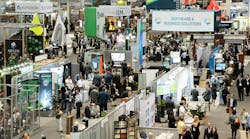In March, the International Code Council—with support from the American Institute of Architects; ASTM International; the American Society of Heating, Refrigerating and Air-Conditioning Engineers (ASHRAE); the U.S. Green Building Council; and the Illuminating Engineering Society—issued the first public version of the International Green Construction Code (IGCC). Although only a first draft, the IGCC is a commendable effort toward raising the bar in building quality. In particular, it is encouraging to see the commissioning (Cx) quality-assurance process defined more extensively than in previous codes and guidelines.
The current version of the code is divided into 12 chapters and four appendices. Chapters 1, 2, 3, and 9 include Cx requirements. Chapter 1 contains administrative procedures and definitions. As in ASHRAE standards, Leadership in Energy and Environmental Design (LEED) requirements, and other sources, Cx is defined as a process verifying design, installation, and function—no startling changes there. The definitions also include the term "approved agency," which appears throughout the code as the Cx provider. There is no further detail on what constitutes an approved agency providing Cx. This could become a point of discussion in the coming months.
Chapter 3 mentions Cx periodic reporting as a jurisdictional option. Chapters 6 and 9 contain the details of Cx requirements. In general, Cx is to be done by an "approved agency" as identified by the "registered design professional in responsible charge." In lieu of this, Cx can be performed directly by the registered design professional in responsible charge.
Chapter 6, "Energy Conservation, Efficiency and Atmospheric Quality," sets the tone for extensive Cx detail. It states, "This chapter shall regulate the design, construction, and commissioning of buildings for the effective use of energy." At the outset, the IGCC seems to be taking a more aggressive stance toward Cx than other sustainable guidelines, such as the LEED green-building rating system.
Chapter 6 discusses the Cx of renewable-energy wind systems as well as energy-efficient appliances. Section 612.1 requires the usual Cx plan and functional-performance testing. However, it also requires a new preliminary Cx report. More importantly, it requires that the code official be notified of the completion of Cx prior to a building passing final mechanical inspection. This is a level of enforcement present in very few current Cx laws. It paves the way for a potentially huge elevation of building quality in the current hierarchy of design, bid, build, and occupy.
The section goes on to require both an operating manual and a maintenance manual within 90 days of receipt of the certificate of occupancy. The combination of these manuals appears to amount to the ASHRAE systems manual, an improvement over the conventional operations-and-maintenance manual.
Another IGCC improvement is Section 612.2, which details mandatory Cx for lighting-sensor, daylighting, timer, and dimming controls. Additionally, Chapter 9 dedicates Section 903 to Cx. The chapter requires both pre- and post-occupancy reports to be submitted to the owner and made available to code officials upon request. It also requires general demonstration of independence and competence.
The majority of the chapter is an extensive table listing systems requiring verification, indicating the required method of verification, and stating whether or not Cx should occur before or after occupancy and if it should be repeated. The table goes on to list nearly 50 line items that can be included in the Cx process, such as materials, energy, lighting, water, and indoor environmental quality. The methods of verification appear inconsistent at this point, but it seems likely the table will be clarified extensively during the public-review process.
A public-comment hearing will be held Aug. 14-22 in Chicago. Results of the hearing will be posted Aug. 31. On Nov. 3, Public Version 2.0 will be issued for code-change submittals, which are due by Jan. 3, 2011. More hearings will be held with the finished code expected to be released in early 2012. More information is available on the IGCC Website at: http://bit.ly/5qSuqr.
A member of HPAC Engineering's Editorial Advisory Board, Ron Wilkinson, PE, LEED AP, is an authority on commissioning Leadership in Energy and Environmental Design (LEED) projects and sustainable buildings. LEED-commissioning project manager for AKF Group LLC, he is the author of the first commissioning training program for LEED for New Construction and Major Renovations, as well as a member of the Building Commissioning Association.






